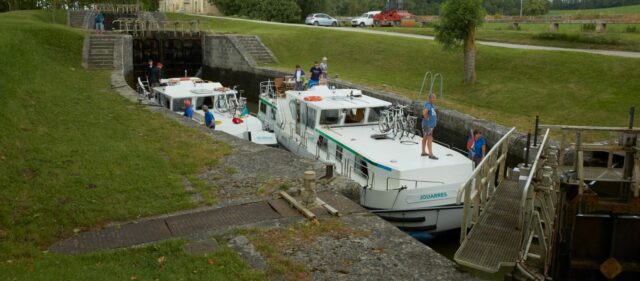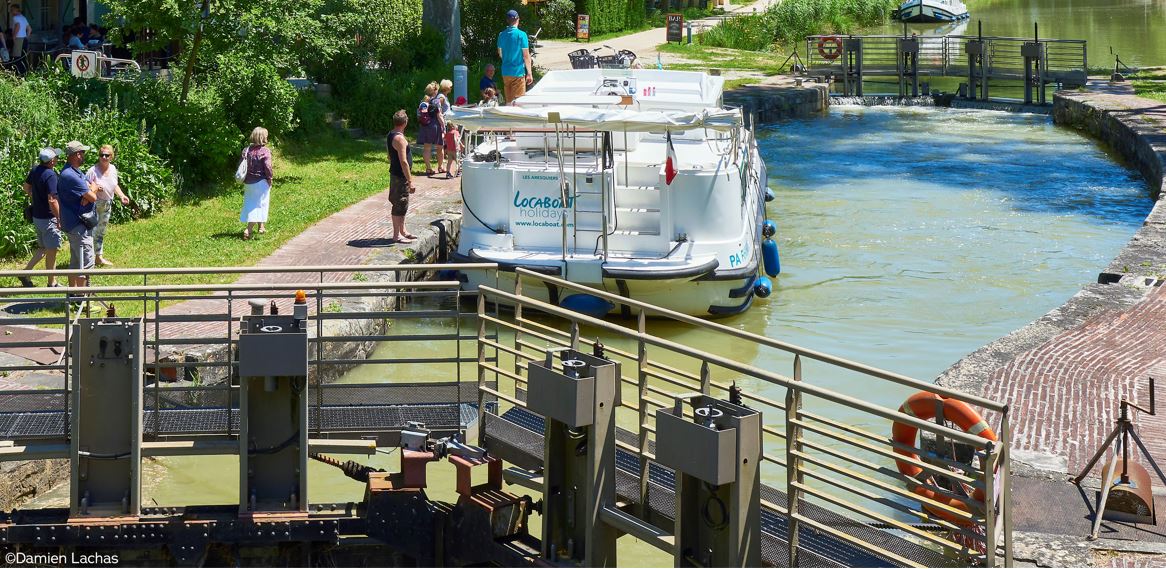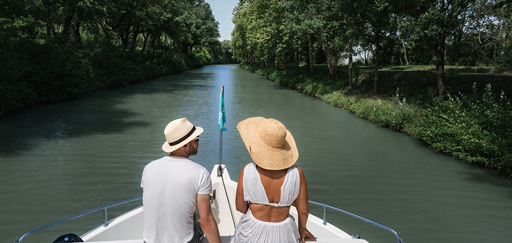Locks enable any boat to rise or descend several metres, with no effort involved, simply by displacing water. The first lock, as we know it, between the River Ourcq and the Seine, was the invention of Leonardo da Vinci at the beginning of the 16th century. It turned out to be an indispensable aid to boat traffic along waterways.
Since then, many locks have been installed. In general, all you really need to negotiate a lock is good team spirit. It is not, strictly speaking, the lock keeper’s job to help you to moor your boat, but most of them do. If you help him or her to open and close the lock gates, you’ll get used to the technical side of how these facilities work, and you’ll be doing the lock keeper a favour as well. The truth is that a willingness to help each other is essential on canals. You need to allow between 15 and 20 minutes to pass through a lock.
Simple rules
The basic rules that you need to bear in mind are as follows:
- Don’t moor your boat in the lock. If you did, when the water level drops, your boat could be left hanging from its mooring.
- Never enter a lock with your engine switched off; if the propeller isn’t turning you won’t be able to steer properly.
- Never jump from the lock side onto the roof of your Pénichette®; it’s dangerous, and you could injure yourself or damage the boat.
- Never wind a mooring rope round your arm or wrist; this can be dangerous.
- Never use your hands or feet to avoid collision: use a boathook.
- Always check with the lock keeper before helping him or her, and follow his or her instructions.
The right attitude in locks

Complying with good practice when passing through a lock is very important. There can however be one or two differences, depending on the country.
- Some lock keepers will ask you to keep your engine running, whilst others will prefer you to switch it off. On the whole, in France, you can leave your motor running, while in Germany you switch it off.
- Don’t forget to warn the lock keeper if you intend stopping between two locks, so that they don’t wait for you at the next lock.
- Remember that barges have absolute priority at locks.
Passing through a rising lock

You need to know the basics before you come to your first lock.
- After a member of your crew has disembarked, enter the lock slowly.
- When you reach the middle, put your engine into reverse in order to stop, then throw the mooring ropes, bow first, to your crew member on the lock side
- The crew member on the lock side must pass the mooring ropes around the bollards and then pass the ends of the ropes to the crew members on board (but never knot the rope round the bollard).
- The lock-keeper will open the paddles of the upper sluice gates. Keep the ropes tight as the water rises so that the boat stays up against the wall of the lock.
- As soon as the water levels are equal, the lock-keeper will open the upper gates.
- Once you have taken the mooring ropes back on board, set off slowly to exit the lock.
Passing through a descending lock
Now that you know how to go up, let’s learn how to go down!
- Enter the lock slowly. As you reach the middle, use reverse to stop the boat. Fasten the boat at the bow and then aft, taking care to ensure that the fenders are in place.
- Leave enough slack on your mooring ropes to allow you to descend between 3 and four metres.
- Ensure that the boat does not reverse too near to the upper gate.
- The lock keeper will open the lower gates. While the water level is going down, be ready to provide more slack as the boat descends.
- Once the level has been reached, the lower gates will be opened and you can take your mooring ropes back on board.
- Manually cast the boat off from the wall of the lock and move away slowly as soon as the gates are fully opened.
You now know the basic techniques for passing through a rising or descending lock. No more stress over this aspect of navigation. Don’t forget that, if you’re not entirely confident the first few times, the lock-keeper is there to guide you if necessary.
In addition, the skipper’s guide will enable you to revise before you arrive at each lock.
Have a good trip!

















![Home_GB[1]](https://www.locaboat.com/wp-content/uploads/2025/02/Home_GB1.png)



